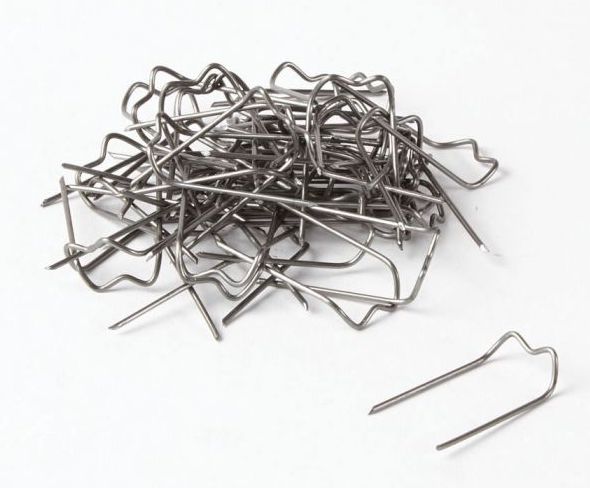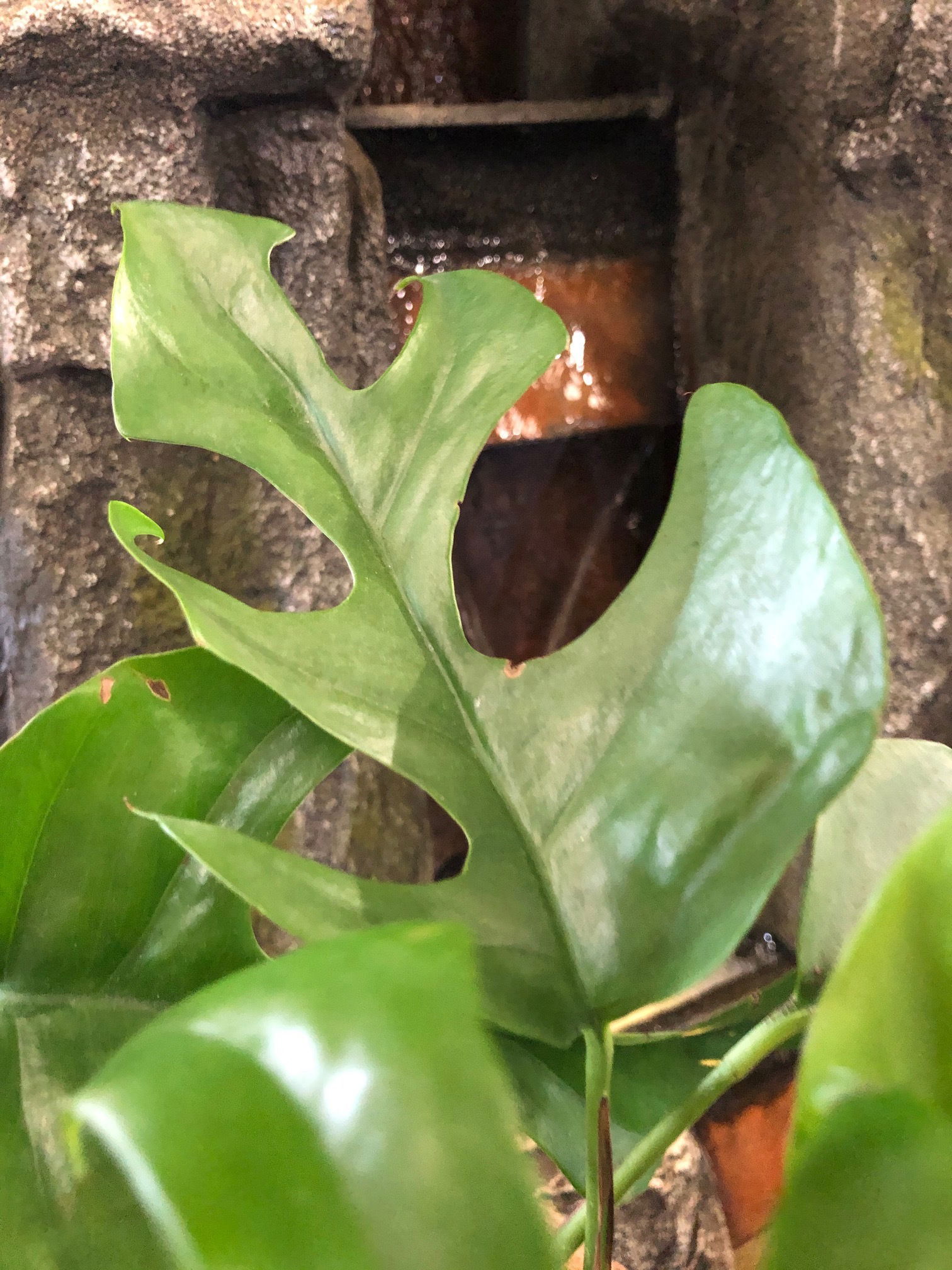
Rhaphidophora tetrasperma
Contents
- Top Tips
- Location, Water, Humidity & Fertilisation
- Common Issues
- Origins, Temperature, Propagation, Repotting & Toxicity
- Combating Mosaic Virus (Symptoms, Causes & Actions Needed)
Need the answer to a specific plant query? Book a 1-to-1 video call with THE HOUSEPLANT DOCTOR™, the website's friendly author, to overcome and address your niggling problem! Available on iMessage, WhatsApp, Facebook Messenger & more.
Top Tips & Info
- Care Difficulty - Easy
- Due to their horizontally leaves (that face across the room to the windows), they can be grown dark areas such as up walls (via self-adhesive hooks), shelves and on corners of furniture.
- Near-continual soil moisture is key for consistent growth, allowing the top third to dry out in between waters.
- Although average room humidity won't be too much of an issue, introduce a pebble tray to promote a reliable environment. Rinse the foliage in the shower every month or two to remove the dust.
- Fertilise using a 'Houseplant' labelled feed every three waters in the spring and summer, reducing this to every four in the colder months.
- Keep an eye out for Spider Mites that'll form webs on the under-leafs of the plant.
- Repot every three years using our 'Monstera' labelled potting mix in spring; water the soil at least 12hrs before the action to reduce the risk of transplant shock. Scroll down to the 'Repotting' section to learn more about repotting a specimen that's attached to a moss pole.
Location & Light - 🔸🔸
A brightly lit spot away from the direct sunlight is best for quality growth. A sunny position that's too sharp will cause a 'washed out' appearance, along with spindly growth and a general decline in health.
The amount of light and current season of the year will directly govern the frequencies of waters per month. Specimens placed in darker areas must be kept on the drier side to life, whereas brighter locations will require more soil moisture to lubricate photosynthesis.
Water - 🔸🔸🔸
Although short-lived droughts won't necessarily hurt this species, consistent irrigations are mandatory for healthy growth. Allow the top third of the soil to dry in between waterings, or a few inches for specimens that are too large to lift. Never allow standing water to accumulate beneath its pot as root rot is a common issue among gardeners. Under-watering symptoms include stunted growth, crispy brown patches forming on the leaves, and wilting; these issues are commonly due to either too much light/heat or forgetfulness. Over-watering symptoms include yellowing lower leaves, leaf blotches in brown, yellow or black, wilting or rotting stems and roots. If the base of the stem is beginning to rot, take stem cuttings and propagate via water.
Humidity - 🔸🔸🔸
Create a humidity tray to provide a moist and stable environment for your plant. If the surrounding saturation is too low or the heat too high, its leaves may start to brown over and curl, especially in direct sunlight. Hose the foliage down from time to time to hydrate the leaves and keep the dust levels down.
Fertilisation - 🔸🔸
Feed every three waters during the growing period and every fourth drink in the autumn and winter, using a 'Houseplant' labelled fertiliser. Never apply a 'Ready to Use’ product into the soil without a pre-water first, as it may burn the roots and lead to yellowed leaves.
Want to train yours up a moss pole? Our Moss Pole Hooks are the perfect tool to keep your specimen growing the way it should! Click here to shop:
Common Issues with Monstera Minima (Rhaphidophora Tetrasperma)
Root rot is a common issue with specimens sat in too moist or waterlogged soil for long periods. Symptoms include rapidly yellowing leaves, stunted growth and a rotten brown base. Take the plant out of the pot and inspect health below the soil line. If the roots sport a yellow tinge, you're good to go, but if they're brown and mushy, action must be taken immediately. More information about addressing root rot can be found on this link.
Mould developing on the soil means two things - too little light and over-watering. Despite the harmlessness of the mould, it'll prove unsightly to most gardeners and is therefore removed once known. To remove, replace the top two inches of the soil for a fresh batch of 'Houseplant' labelled compost. Either increase the amount of light received (no direct sunlight for the first few weeks to prevent environmental shock) or decrease the frequency of waters slightly. If the mould is accompanied by yellowing lower leaves, you may also have a case of root rot.
Is your Monstera Minima producing smaller leaves or just naked, leggy stems each time it grows? It's most likely to do with its light levels or low temperatures. We recommend improving its location by placing it in a sunless windowsill or under a grow light for better, more reliable growth. You can also consider pruning any leggy, leafless stems back to the first leaf to promote a new cluster of foliage in months to come. Other reasons for its reduction of leaf size could be: an absence of a moss pole or plant to climb up, a lack of fertilisation and/or root rot.
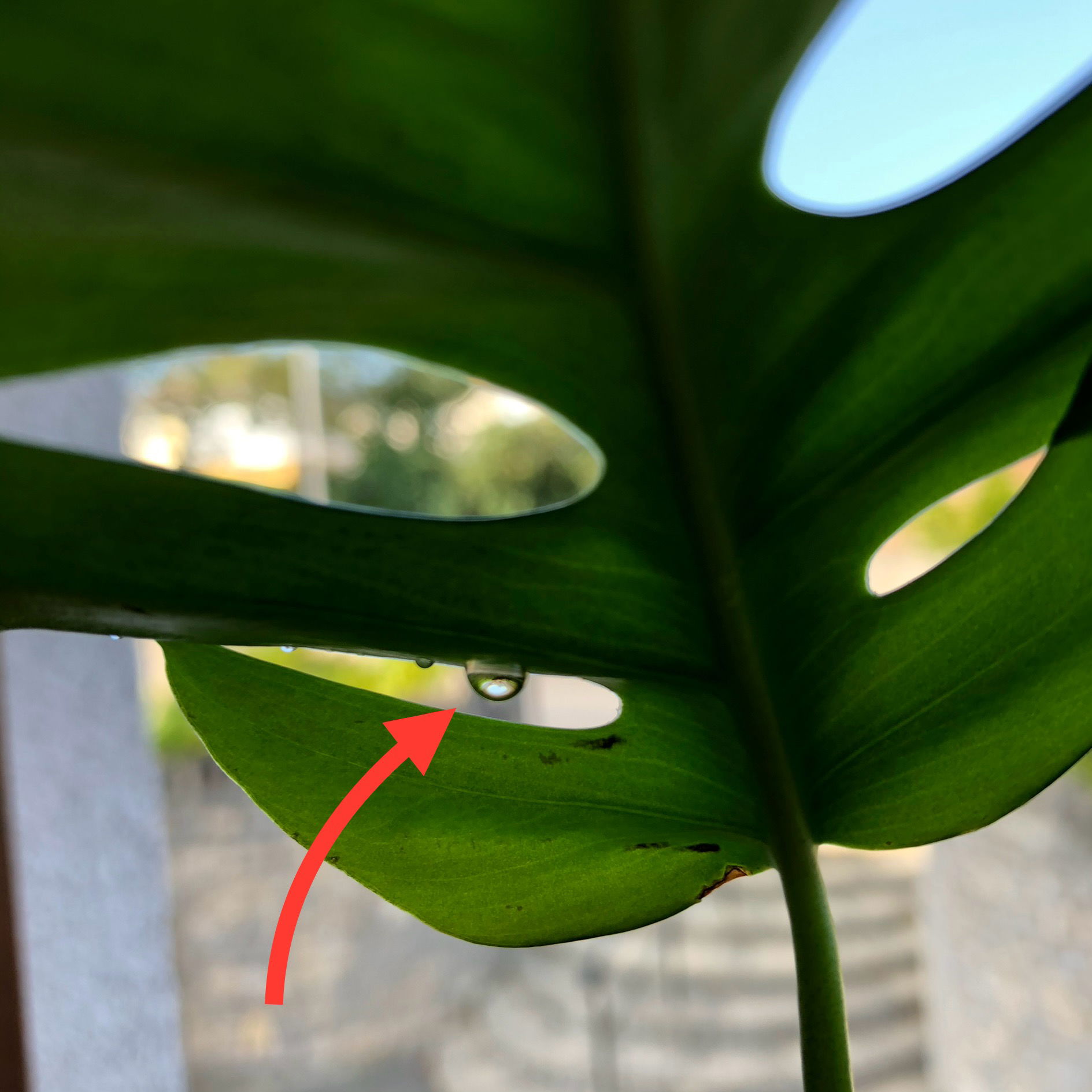
Guttation (above) is a perfectly normal phenomenon, but it may signify slight over-watering or dry air. Moisture is absorbed through the roots and will exit the plant via the stomata, called 'transpirational pull'. In situations of coldness, dry air or at night, the stomata will shut, leading to an imbalance within the plant. As the pressure mounds with the roots continuing to draw in moisture, small droplets will appear around the edges of the leaves. Although in some cases, it could be the product of over-watering, nine times out of ten, it's harmless and requires no difference in care.
Spider Mites are small, near-transparent critters, that'll slowly suck out the chlorophyll out of the leaves. Have a check under the leaves, most notably along the midrib, for small webs and gritty yellow bumps. Click here to read our article about the eradicating Spider Mite, along with some extra tips that you may not find elsewhere!
Too low humidity can cause browning leaf tips with yellow halos. Although this won't kill your specimen, you may want to increase the local moisture to prevent the new growth from adopting these symptoms. Mist or rinse the foliage from time to time and create a humidity tray whilst the heaters are active to create a stable environment for your specimen.
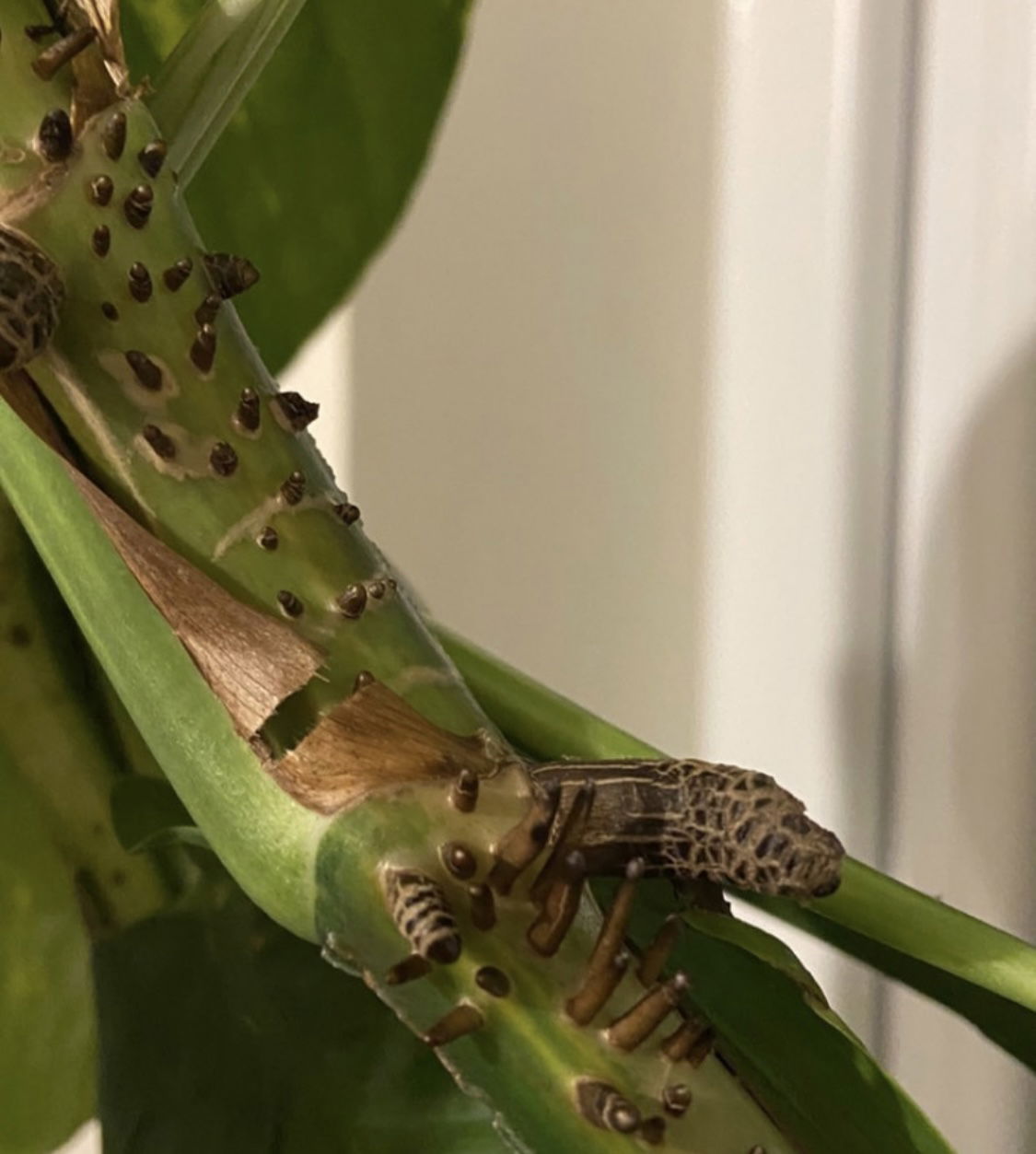 Short brown bumps on your plant's vines are dormant root nodes that'll spring into life when exposed to moisture. In the wild, these root nodes will emerge and stick onto the nearest tree or structure, allowing the plant to reach the tree's canopy in record time.
Short brown bumps on your plant's vines are dormant root nodes that'll spring into life when exposed to moisture. In the wild, these root nodes will emerge and stick onto the nearest tree or structure, allowing the plant to reach the tree's canopy in record time.
Yellowing lower leaves (closest to soil) are a clear sign of over-watering, usually caused by too little light. Although they can do well in darker locations, the frequency of irrigations must be reduced to counteract the chance of root rot. People don't realise that a plant's root system needs access to oxygen too; when soil is watered, the air will travel upwards and out of the potting mix. A lack of accessible oxygen for the roots will cause them to subsequently breakdown over the oncoming days. Click on this link to learn more about root rot and how to address it, and always feel the pot's weight for confirmation (heaviness = good soil moisture, & vice versa).
The browning of the cataphyll shouldn't of be a concern, as it's a wholly natural process which affects all specimens across the world. Remove the brown section once it becomes dry and crispy, using a clean pair of scissors or peeling it back by hand.
Failed propagated stem cuttings - There are several reasons why the cuttings haven't rooted well, including: the time of year (spring or summer is best), its size (Monstera cuttings should have at least three leaves), poor growing conditions (replace water weekly for water-propagated cuttings, and avoid over-watering for soil-grown plants), and its growing environment (a bright sunless windowsill and warmth is important).
Origins
Rhaphidophora is a genus of around one hundred species that originates from south-east Asia and Australasia. One of the more popular species, R. tetrasperma, has natural distributions around south Thailand to north Malaysia and was first described by Joseph Dalton Hooker in 1893. The word 'Rhaphidophora' could have Latin descent, referring to the 'needle-like' oxalates found in the plant's centre. The species' epithet, 'tetrasperma', refers to the four-sided seeds that are produced in the autumn months.
The genus is paraphyletic to Epipremnum, with R. tetrasperma being commonly confused with E. pinnatum due to their similar appearances.
 The Distribution of Rhaphidophora tetrasperma
The Distribution of Rhaphidophora tetrasperma
Temperature
12° - 30°C (54° - 86°F)
H1b (Hardiness Zone 12) - Can be grown outdoors during the summer in a sheltered location with temperatures above 12℃ (54℉), but is fine to remain indoors, too. If you decide to bring this plant outdoors, don't allow it to endure any direct sunlight as it may result in sun-scorch and dehydration. Regularly keep an eye out for pests, especially when re-introducing it back indoors.
Spread
Up to 4m in height and 0.8m in width. The ultimate height will take between 5 - 10 years to achieve, with up to 40cm of growth put out each season. Those that naturally grow in the wild can reach heights of up to fifteen metres; however, with smaller root systems and less favourable growing conditions, they'll only grow to five metres, give or take.
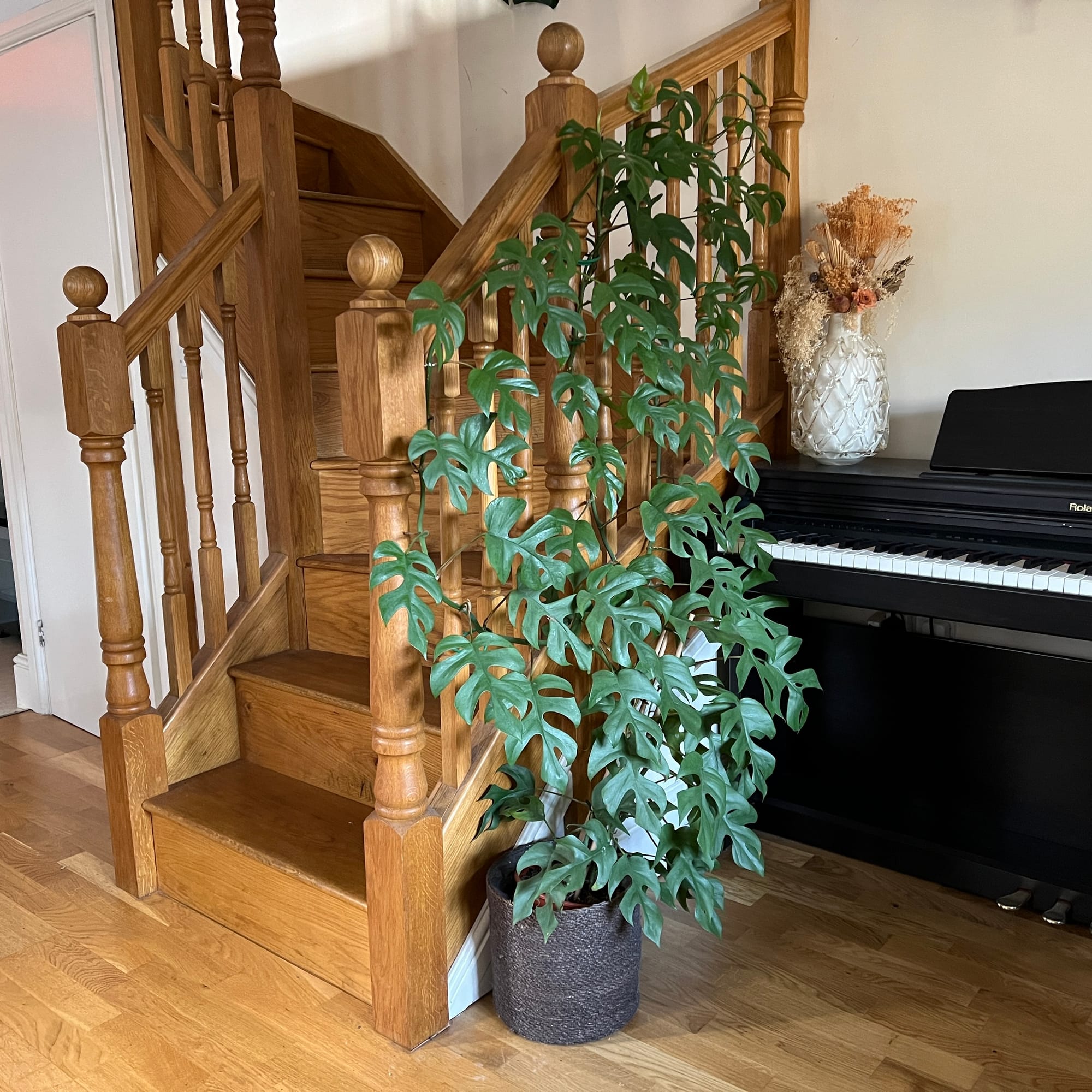 Here's a Monstera Minima being trained along our wooden stairwell with string.
Here's a Monstera Minima being trained along our wooden stairwell with string.
Pruning & Maintenance
Remove yellow or dying leaves, and plant debris to encourage better-growing conditions. While pruning, always use clean scissors or shears to reduce the chance of bacterial and fungal diseases. Never cut through yellowed tissue as this may cause further damage in the likes of diseases or bacterial infections. Remember to make clean incisions as too-damaged wounds may shock the plant, causing weakened growth and a decline in health.
Although the aerial roots aren't exactly appealing, you mustn't remove them as this can stress the plant and potentially weaken it.
Propagation
Via Seed or Stem Cuttings.
Stem Cuttings via Water Propagation (Easy)
- Choose the healthiest, most established vines. This propagation method can be taken from spring to summer, using between two to five leaves, with the vine being at least 8cm (2.5 inches) in length with two nodes (one for foliar development and the other for root growth). Although more nodes are fine, be sure only to submerge the bottom ones in water to avoid unneeded rooting elsewhere on the stem. (More on this later)
- Cut directly below a node using a clean knife to reduce bacteria count. Remove the lower half of the leaves and place the vines into a container of lukewarm water. Be sure to submerge at least one node into the water, or else the root development will be hindered.
- The leaves must stay above the waterline for the prevention of disease.
- Replace the water weekly, using lukewarm water to avert shocking the cutting with cold temperatures.
- Once the roots surpass 4cm (2 inches) in length, it's time to pot the cutting.
- Choose a potting mix - as long as it has a well-draining nature, most soils are fine. Either 'Houseplant' labelled compost or our Monstera Potting Mix is suitable for potting up.
- Use a 7cm (2 inch) plastic or coir pot that has suitable drainage holes. Try not to transplant the cuttings too deeply in the soil as rot may occur.
- Fill the bottom quarter of the pot with soil, before sitting the cutting on top. Fill the remaining gaps with compost until the soil line reaches four-fifths of the pot's height. Lightly tap the pot's side to consolidate the soil into place. (Don't press down on the soil!)
- Provide bright, indirect light in a windowsill or under a grow light, along good humidity by placing the potted plant into a transparent plastic bag for the first couple of weeks.
- Open the bag every two days for an hour for the prevention of disease. After a month of being placed in soil, remove it from the bag and follow the care tips provided above.
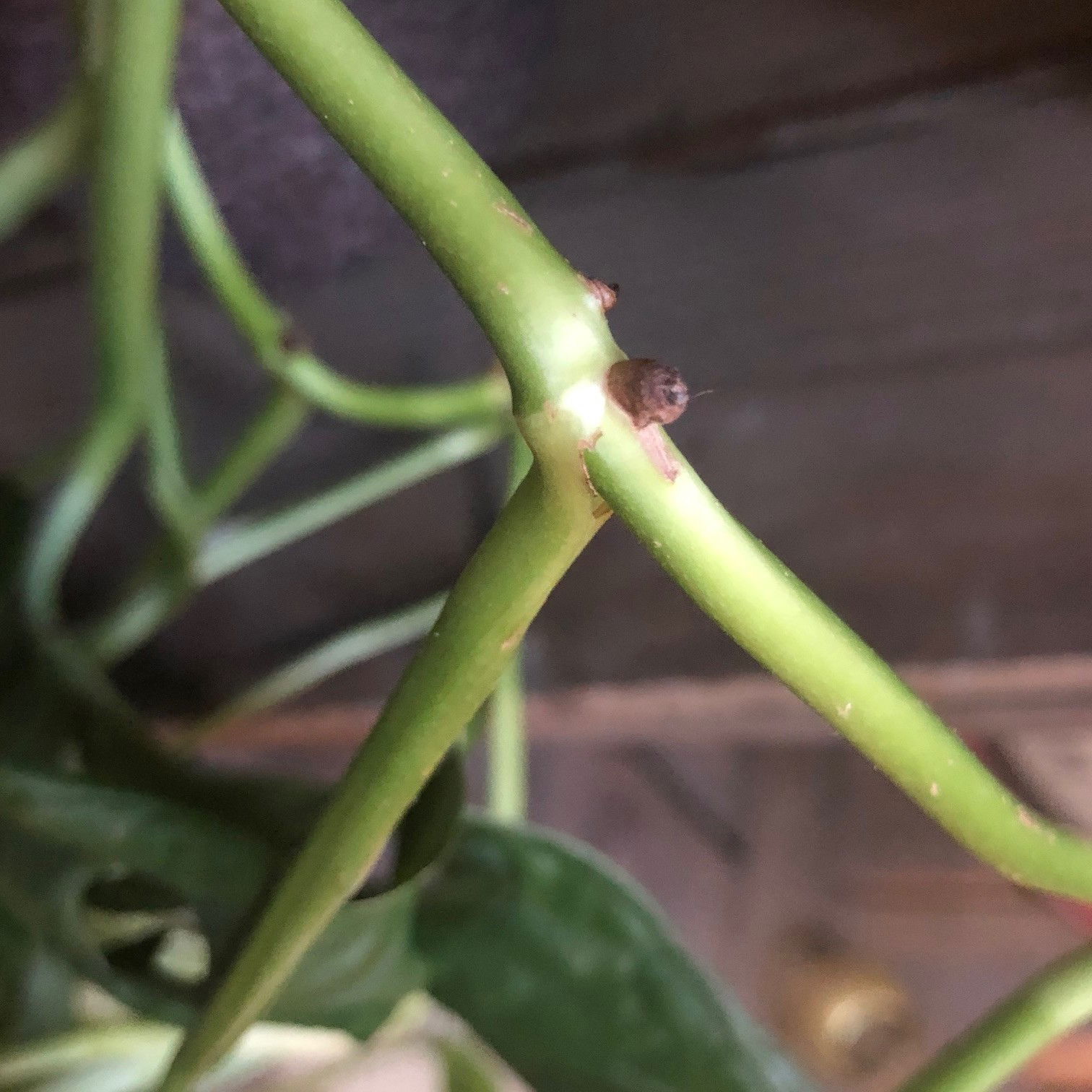 Pictured here is a node that can produce a new branch of foliage and aerial roots to start off the propagation process.
Pictured here is a node that can produce a new branch of foliage and aerial roots to start off the propagation process.
Stem Cuttings via Soil Propagation (Moderate)
- Choose the healthiest, most established vines. This propagation method can be taken from spring to summer, using between two to five leaves, with the vine being at least 8cm (2.5 inches) in length with two nodes (one for foliar development and the other for root growth). Although more nodes are fine, be sure only to submerge the bottom ones in water to avoid unneeded rooting elsewhere on the stem. (More on this later)
- Cut directly below a node using a clean knife to reduce bacteria count. Remove the lower half of the leaves and place the vines into a container of lukewarm water. Be sure to submerge at least one node into the soil, or else the root development will be hindered.
- Choose a potting mix - as long as it has a well-draining nature, most soils are fine. Either 'Houseplant' labelled compost or our Monstera Potting Mix is suitable for potting up.
- Use a 7cm (2 inch) plastic or coir pot that has suitable drainage holes. Try not to transplant the cuttings too deeply in the soil as rot may occur.
- Fill the bottom quarter of the pot with soil, before sitting the cutting on top.
- Fill the remaining gaps with compost until the soil line reaches four-fifths of the pot's height. Lightly tap the pot's side to consolidate the soil into place. The leaves must always stay above the soil-line for the prevention of disease.
- Provide bright, indirect light in a windowsill or under a grow light, along good humidity by placing the potted plant into a transparent plastic bag for the first couple of weeks. Humidity will be your cutting's best friend, so ensure the plant doesn't dehydrate because of dry air.
- Open the bag every two days for an hour for the prevention of disease. After a month of being placed in soil, remove it from the bag and follow the care tips provided above.
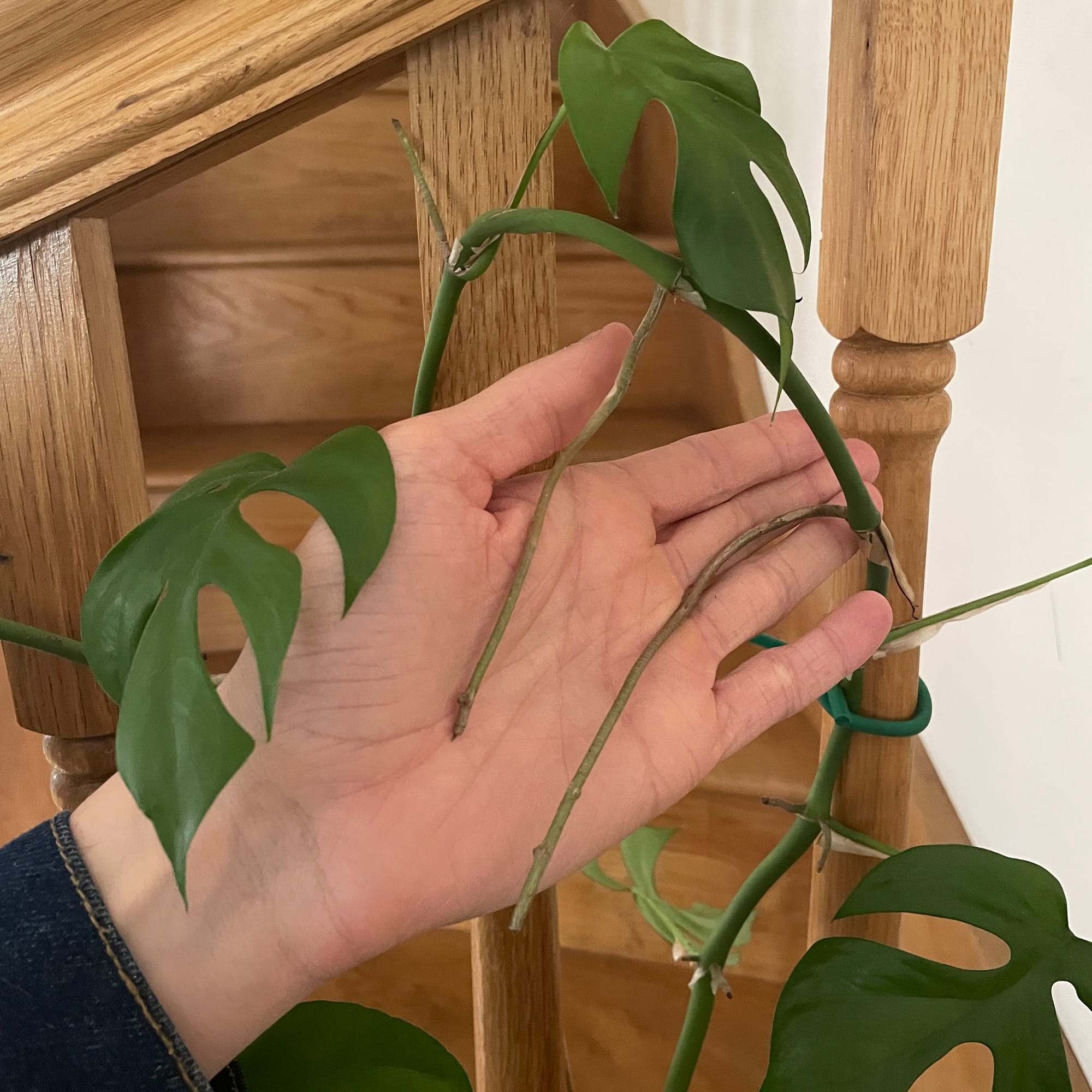 Thin aerial roots are common on Raphidophora tetrasperma (Monstera Minima) and can sometimes fuse to walls or furniture!
Thin aerial roots are common on Raphidophora tetrasperma (Monstera Minima) and can sometimes fuse to walls or furniture!
Flowers
Monstera Minima (Rhaphidophora tetrasperma) is part of the Araceæ family, meaning that they'll produce toxic flowers. Its inflorescences bare large similarities to Peace Lilies, with a modified leaf (spathe) circulating around the site of pollination (spadix). Despite its readiness to flower in the wild, those grown domestically will rarely flower due to the unfavoured growing conditions.
Repotting
Repot every three years using our 'Monstera' labelled potting mix and the next sized pot with adequate drainage. Hydrate the plant 24hrs before tinkering with the roots to prevent the risk of transplant shock. For those that are situated in a darker location, add a thin layer of small grit in the pot's base to improve drainage and downplay over-watering. Click here for a detailed step-by-step guide on transplantation, or via this link to learn about repotting with root rot.
If you're thinking of repotting a specimen that's growing up a moss pole, never remove the attached aerial roots as the disturbance could put further stress on the plant. Extend by purchasing another same-sized pole and pushing directly into the hollow hole in the original's top - its moss-like material may have to be cut off from the top to access the hollow centre. Get a long, sturdy stick that has a similar length to the two poles combined and place in the two's centre to support the weight. Always perform the repot BEFORE adding another pole, as it'll prove more challenging due to the weight distribution and overall balance. NEVER remove soil from the roots, or over-touch the root system, as this will cause transplant shock and possible death.
Pests & Diseases
Keep an eye out for mealybugs, spider mites, scale, thrips & whitefly that'll locate themselves in the cubbyholes and undersides of the leaves. Common diseases associated with Rhaphidophora are root rot, red leaf-spot, botrytis & southern blight - click here to learn more about these issues.
Toxicity
This plant is classified as poisonous due to varying concentrations of calcium oxalate crystals found around the plant's body. If parts of the plants are eaten, vomiting, nausea and a loss of appetite could occur. Consumption of large quantities must be dealt with quickly; acquire medical assistance for further information.
Retail Locations
Online Stores.
Additional Section: Combating Mosaic Virus
Symptoms - This virus is most likely to attack Aroids like Monstera, Rhaphidophora and Philodendrons, causing small, yellow lesions or patterns to on the leaves. At first, symptoms look similar to a nutrient deficiency or over-exposure to the sunlight, but as conditions worsen, you'll eventually find colonies of deeper affected areas.
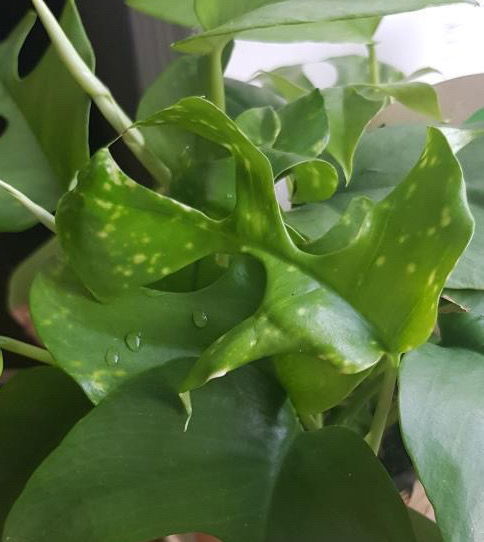 Typical lesions of Mosaic Virus.
Typical lesions of Mosaic Virus.
Causes - The virus is usually pre-existent within the plant's cellular make-up, but some cases may arise from neighbouring plants. Other reasons include the multi-use of pruning scissors without being washed in between utilisation, re-using old potting mix, and pests that may spread from plant to plant, thus taking the virus with them.
Action Needed
- Inspect and remove any seriously-affected areas with a clean pair of scissors. Be sure to thoroughly wash the utensil afterwards with hot soapy water to avert a spread.
- Take the plant outside and perform a gentle hose-down. Although this won't directly remove the disease, it'll remove the thin layer of dust that will increase photosynthesis and therefore energy production. Repeat this step monthly.
- Cast an eye over the plant for further development, removing any affected areas or fallen debris as you go.
- Quarantine the specimen at least 50cm (almost 2ft) from other plants and try to segregate accessories (watering cans, etc.).
- Unfortunately, there are no known products that can wholly remove this disease. It'll be highly unlikely to eradicate this problem, so keeping maintained control and regular feeds will help contain the disease.
- Supplement using a nitrogen-based fertiliser ('houseplant'-labelled feed) to help the development of new, disease-free growth. This will help the production of photosynthesis that'll promote stored energy within the plant, thus giving it the best chance of survival. If you have a newly-purchased specimen, be sure to contact the store or grower to make them aware of the virus, as this is most likely affecting other customers.
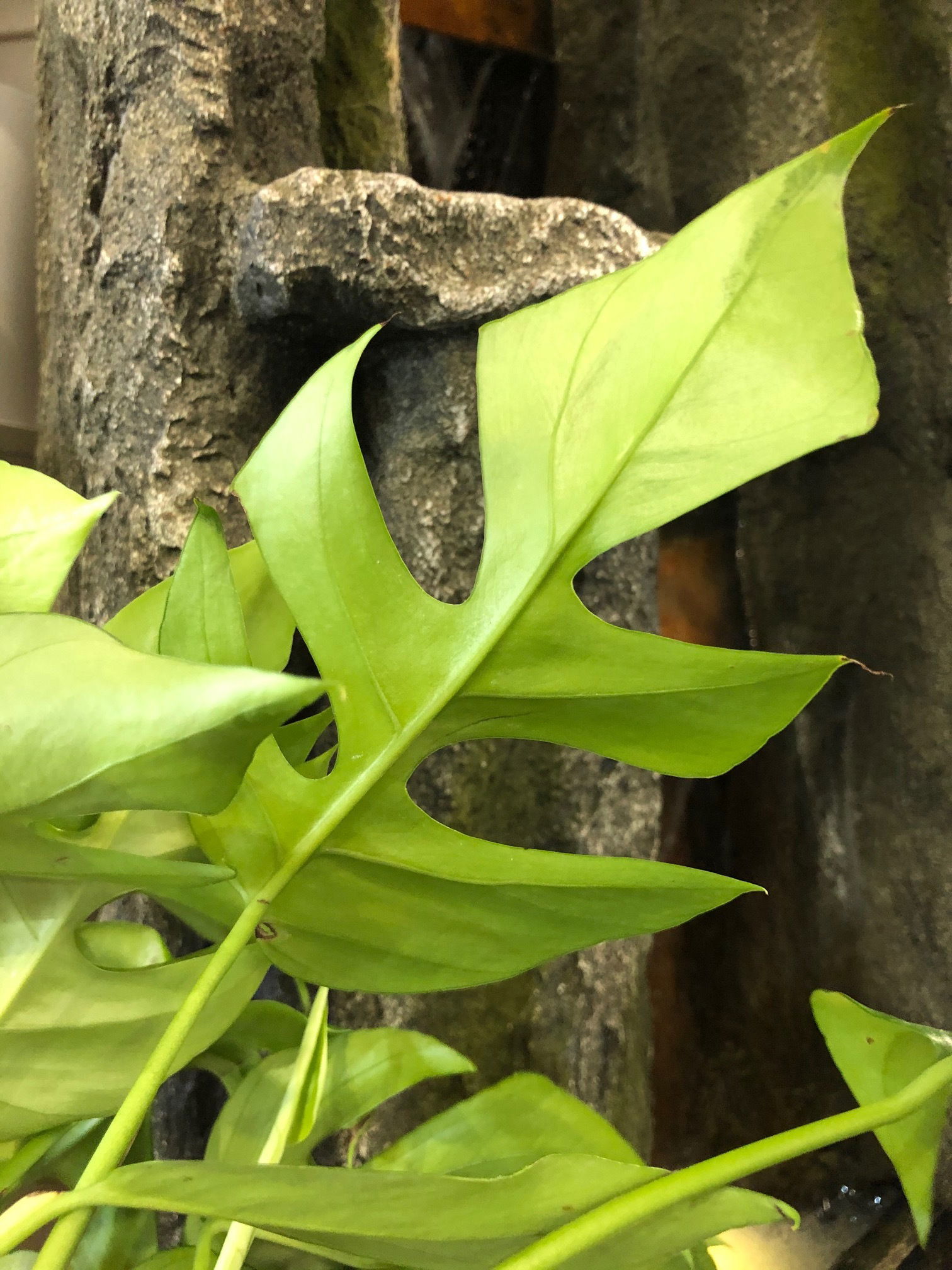 Spider Mites are another key issue with Rhaphidophora, most likely to conjugate along the midrib & creases of the leaves. Click on the photo to learn more.
Spider Mites are another key issue with Rhaphidophora, most likely to conjugate along the midrib & creases of the leaves. Click on the photo to learn more.
Book a 1-to-1 Call with THE HOUSEPLANT DOCTOR™
If you need further advice with your houseplants, book an advice call with ukhouseplants' friendly and expert writer today! This can be done via a video or audio call on most apps, including Facebook, FaceTime & Skype. A ten-minute call costs £5.99 (US$7), or £15.99 for thirty minutes. You can ask multiple questions, including queries on plants, pests, terrariums, repotting advice and anything in between. Please consider supporting this service to keep ukhouseplants thriving!
